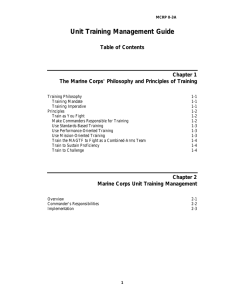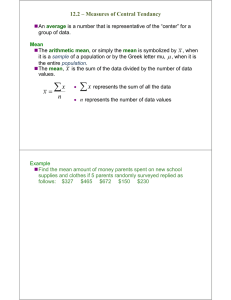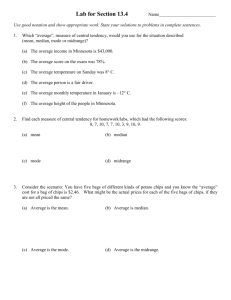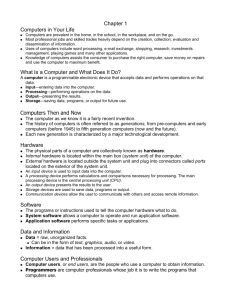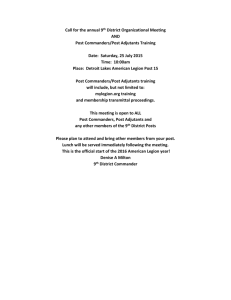Training Plans Chapter 6 Section I. Fundamentals The Planning Process
advertisement
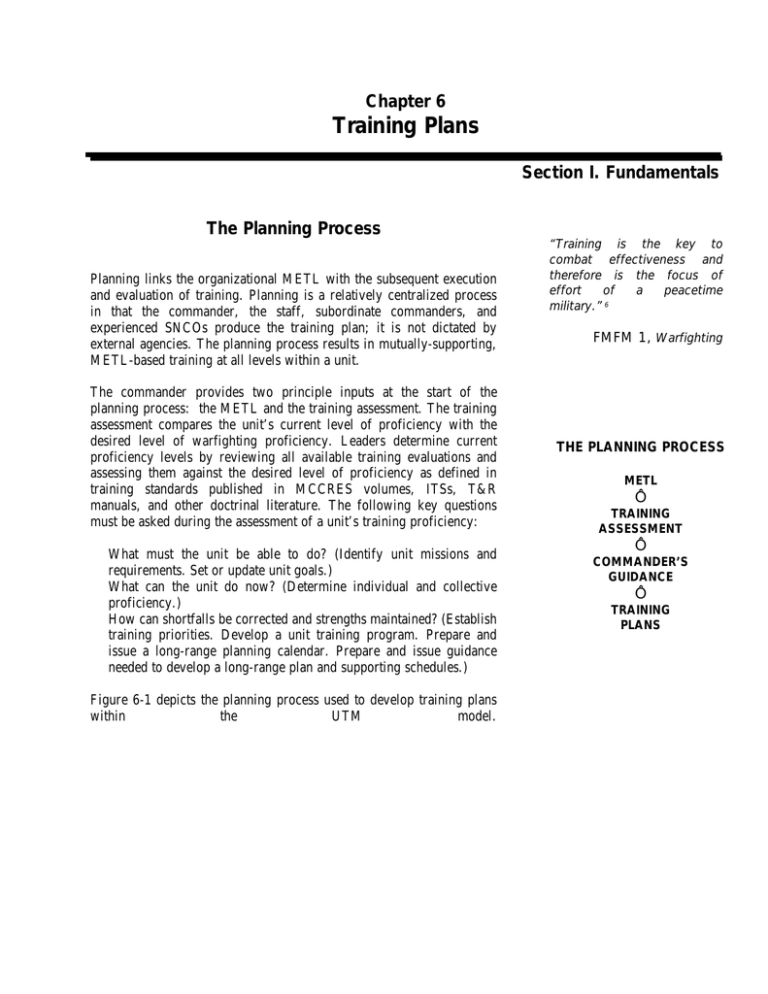
Chapter 6 Training Plans Section I. Fundamentals The Planning Process Planning links the organizational METL with the subsequent execution and evaluation of training. Planning is a relatively centralized process in that the commander, the staff, subordinate commanders, and experienced SNCOs produce the training plan; it is not dictated by external agencies. The planning process results in mutually-supporting, METL-based training at all levels within a unit. The commander provides two principle inputs at the start of the planning process: the METL and the training assessment. The training assessment compares the unit’s current level of proficiency with the desired level of warfighting proficiency. Leaders determine current proficiency levels by reviewing all available training evaluations and assessing them against the desired level of proficiency as defined in training standards published in MCCRES volumes, ITSs, T&R manuals, and other doctrinal literature. The following key questions must be asked during the assessment of a unit’s training proficiency: What must the unit be able to do? (Identify unit missions and requirements. Set or update unit goals.) What can the unit do now? (Determine individual and collective proficiency.) How can shortfalls be corrected and strengths maintained? (Establish training priorities. Develop a unit training program. Prepare and issue a long-range planning calendar. Prepare and issue guidance needed to develop a long-range plan and supporting schedules.) Figure 6-1 depicts the planning process used to develop training plans within the UTM model. “Training is the key to combat effectiveness and therefore is the focus of effort of a peacetime military.” 6 FMFM 1, Warfighting THE PLANNING PROCESS METL Ô TRAINING ASSESSMENT Ô COMMANDER’S GUIDANCE Ô TRAINING PLANS MCTEEP Marine Corps Training, Exercise, and Employment Plan (MCTEEP) provides the Marine Corps with a standard scheduling/ planning tool. From its inception, MCTEEP software was designed to be a management tool that was capable of identifying unit, personnel, and resource conflicts prior to the execution of training exercises, deployments, or actual contingency operations. It standardizes training, exercise, and employment plan formats throughout the Marine Corps. This software program allows Fleet Marine Force commanders (battalion/squadron) and higher level staffs to plan and project training, exercises, and employment activities that fulfill mission requirements and ensure the prudent expenditure of resources (personnel, equipment, and money). MCTEEP capitalizes on the availability of Windows-based computer hardware down to battalion and squadron command levels. MCRP 3-0A Unit Training Management Guide 2 MCTEEP’s utility and strengths are as follows: It is an established, yet evolving, software tool developed by the Marine Corps. It was specifically designed to help the Fleet Marine Force commanders manage commitments, examine unit activity data, and reduce the tempo of operations. It uses a multifunctional Gantt display to graphically depict the contents of the underlying database. It uses standard and ad-hoc query reports, which were designed and standardized by the Marine Corps operations community, to sort and filter information. Force lists, deployment tempo, unit availa- bility, and conflict identification information can be readily accessed from the database. It can interface with several other automated information systems; including JULLS, EXSCHED, MDSS II, MAGTF II, and JOPES. MCTEEP reporting requirements are as follows: Quarterly submission of a consolidated MCTEEP from the Commander, Marine Forces to HQMC Plans, Policies, and Operations (PPO) for the current fiscal year, plus two fiscal years out. Reports are submitted electronically via secure medium. The consolidated report contains information down to the battalion and squadron level. Reporting information must include actual manning levels of units; geographic location of exercise or deployment sites; and accurate fiscal, equipment, and SORTS information. Out of cycle MCTEEP updates should also be collected from subordinate units when significant changes occur in scheduled or projected events/exercises. Types of Training Plans There are three types of training plans: long-range, midrange, and short-range. Divisions, wings, the force service support group, and higher commands generally prepare long-range plans. The long-range plan covers a minimum of 24 months and is updated annually. Regiments; Marine wing support groups; Marine aircraft groups; the surveillance, reconnaissance, and intelligence groups; and down through battalion/squadron commanders generally prepare midrange plans. The midrange plan covers up to 18 months and is updated quarterly. Battalions, squadrons, and lower commands typically prepare short-range plans. Short-range planning provides greater detail to the midrange plan and focuses specifically on the immediate quarter. It can include the quarterly update of midrange plans and production of monthly/weekly training schedules. If properly developed, training plans will— 3 Unit Training Management Guide MCRP 3-0A Maintain a consistent combat focus. Each headquarters in the organization involves its subordinate headquarters in the development of training plans. Based on the higher headquarters’ plan, subordinate commanders prepare plans that have a combat focus that is congruous throughout the unit. Coordinate between associated combat, combat support, and combat service support organizations. MAGTF commanders plan for coordinated combined-arms and services training of their task organizations. All MAGTF component commanders actively participate in this process and develop complementary training plans. MAGTF commanders require integrated training plans and must monitor and coordinate their efforts with component commanders during the planning process. Focus on real-world lead times. Training plans must reflect the realworld lead times required to cause the desired effect. If commanders want to influence the fiscal year program objective memorandum, their long-range plans must be submitted to the appropriate headquarters in enough time for that headquarters to incorporate the planning requirements into the budget process. Commanders must look ahead to unit deployment program rotations, deployments, major exercises, and budget cycles, and then provide the appropriate guidance in their planning process. Address future proficiency. Training plans must focus on raising or sustaining the proficiency level of mission-essential tasks to Marine Corps standards. Use resources efficiently. Since time and resources are limited, the planning process must identify the time and resources needed to effectively achieve and sustain combat proficiency levels. Establishing Training Priorities The establishment of training priorities helps the planner determine what should be fit into the training plan first. Priorities must be established and clearly understood. Training priorities come from various sources. Some are assigned by higher headquarters, others are determined during the latest update of the training plan. To establish training priorities, commanders compare unit missions with current proficiency and then determine the relative training emphasis each mission should receive (see MCO 1553.3). By prioritizing training, commanders remain focused in the allocation of limited training resources. Training is prioritized in the following order: mission-oriented training, formal training, and ancillary training. Training that is critical to mission accomplishment and the welfare of individual Marines receives top priority. Changes in the unit’s mission may change existing priorities. Therefore, commanders periodically review priorities to determine if they are still valid. If time or insufficient resources prevents the accomplishment of all the MCRP 3-0A Unit Training Management Guide 4 required training elements, the authority to defer and/or exempt training must come from the commanding generals of MARFORLANT, MARFORPAC, MARFORRES, and the supporting establishment commands. The authority to defer and/or exempt training may be delegated down the chain of command to battalion/squadron commanders. Training Techniques Training exercises must use time and training resources efficiently. There are several training techniques that commanders can use to meet the objectives of the unit training program. These techniques can be applied individually or they can be combined. Multiechelon Training Marines are grouped by echelon or position; then the groups are trained separately, but simultaneously, to meet specific training needs at their echelons. The tasks are trained individually, collectively, or both, and are not necessarily related. This technique is used to manage training that precedes complex collective training or to sustain current levels of proficiency. An example of multiechelon training could be Marines receiving MOS training from selected noncommissioned officers (NCOs) at the squad, crew, or team level, while other NCOs and officers sharpen their leadership skills in a command post exercise (CPX). Individual Training During Collective Training Collective tasks and missions also consist of individual, leader, and team tasks. This allows instructors to address individual, leader, and team tasks while they are teaching collective tasks. This means training on more than one task can be conducted concurrently. Training individual tasks during collective training is an efficient and effective way to conduct training; however, it requires careful planning by commanders and subordinate leaders. Commanders and subordinate leaders must be familiar with the tasks to be trained so they can design a realistic scenario, recognize skills that need improvement, and know when the task should be completed. This type of training works well with skill progression training, which builds upon previously learned tasks to develop new or supervisory skills. 5 Unit Training Management Guide MCRP 3-0A Note Training that involves the initial learning of a new skill or task is not a good candidate for a collective training session. Initial skills training is where Marines learn about the task, develop their skills, and obtain proficiency in the task. This type of training requires individualized study and close supervision by instructors. Concurrent Training During concurrent training, groups of Marines train simultaneously on different tasks. These tasks may or may not be related. For example, a leader may separate a unit at the rifle range into firing relays. Individuals who are not firing may train on preliminary marksmanship instructions, target detection, individual decontamination procedures, or map reading. Prime Time for Training Prime time for training is when specific blocks of time are set aside exclusively for training. Everything from capability exercises to guard duty compete for precious training time. Because of the necessity to support other requirements, not all units can be assigned prime time for training at the same time. During training, a unit’s focus should be on its mission-essential tasks. Creating an environment that frees a unit from performing unnecessary nonmission-essential tasks during its planned training is critical. For example, while one unit focuses on mission-essential tasks, the commander can temporarily rotate the training unit’s responsibilities for nonmission-essential tasks (e.g., policing details, working parties) to another unit. The assignment of nonmission-essential tasks to another unit for a given period of time allows the training unit to focus on mission-essential training tasks. Hip-Pocket Training Prime time training and mission training cycles are not the only time units focus on mission-essential training. Almost every day there is some unused time during which training can be accomplished. Leaders should take maximum advantage of this opportunity with previously planned alternate or hip-pocket training events. Hip-pocket training should be ready in case unforeseen events cause delays or cancellation of the planned training event. This is often a good way to accomplish ancillary training. MCRP 3-0A Unit Training Management Guide 6 Requirement for Long-Range Planning Commanders and their staffs conduct long-range planning to: Identify missions and assign priorities. Develop command goals. Develop a strategy for accomplishing the training program. Ensure resources are available to implement necessary training. Long-range planning begins months before scheduled training. Unit commanders above battalion/squadron level should prepare a longrange plan that covers a two year period and update it on a yearly basis. Long-range planning allows commanders to identify training needs, develop goals, program resources, and prepare guidance for both the training program and resources. Elements of a Long-Range Training Plan Command Training Guidance Command training guidance is published at all command levels to document the organization’s long-range training plan. It must be read and understood by all commanders, staff officers, SNCOs, and NCOs. It is used as a reference for the planning, execution, and assessment of training throughout the long-range planning process. Senior commanders (e.g., Commander, Marine Forces, Marine expeditionary force, wing, division, force service support group) publish their training guidance in advance in order to provide adequate planning time for their troop-listed combat units and supporting peacetime organizations. Guidance at these senior levels is critical to the development and integration of a large number of subordinate training plans. Therefore, long lead times are the norm. Command training guidance addresses, but it not limited to, the following: Commander’s training philosophy (see app. D for a sample commander’s training philosophy and guidance letter). METL. Section II. Long-Range Planning Combined-arms training. Major training events and exercises. Leader training. Individual training. Formal training requirements. Standardization. Training evaluation and feedback. New equipment training. Resource allocation. Long-Range Planning Calendar All echelons, division and higher, publish a long-range planning calendar concurrently with the command training guidance. The calendar graphically depicts the schedule of events described in the command training guidance. Commanders coordinate long-range planning calendars with higher and subordinate commanders, support agencies (such as medical commands), and any other organizations that impact the unit’s training plan. See appendix E for a sample planning calendar. Training Events Senior commanders link training strategies to executable training plans by designing and scheduling training events. By developing and coordinating training events, the organization brings together, at one time, training areas and facilities, OPFORs, controllers, evaluators, and other resources that create the most realistic and combat-focused training. During long-range planning, commanders and their staffs— Make a broad assessment of the number, type, and duration of training events required to accomplish METL training. Develop combat, mission-related scenarios. Focus the entire organization on several METL tasks. Integrate all MAGTF elements into coordinated combined-arms and services training. Major training events are the common building blocks that support an MCRP 3-0A Unit Training Management Guide 2 integrated set of METL-related training requirements. If major training events are included in long-range training plans, they can provide the framework for resource allocation/justification and early planning guidance to subordinate commanders and staffs. 3 Unit Training Management Guide MCRP 3-0A Large-scale training events must be planned so that senior commanders can exercise and integrate all MAGTF elements within their organizations. The maximum training value of large-scale exercises is obtained when subordinate headquarters participate in the development of multiechelon training objectives and scenarios. Each MAGTF unit’s METL should be exercised during the course of the exercise; this can only be accomplished if foresight is used in the design of the long-range plan. Integration of METL-related MPSs into major exercises will ensure effective training at all levels. The Marine Corps has increasingly emphasized externally supported training events in which an external agency provides assistance in the form of detailed planning, additional resources, and evaluation. Mountain Warfare Training Center and Marine Corps Air-Ground Combat Center are examples of organizations that provide externally supported, combined-arms training. Support provided by these organizations usually includes a METL-derived scenario with associated OPFORs, ob- server-controllers, and evaluation support. Training events are developed based on each participating organization’s METL and try to mimic realistic combat conditions. Training Resources The commander uses METL assessment to determine resource priorities for training. During long-range planning, constrained resources may require deletion of low-priority training requirements, substitution of less costly training alternatives, or requests to higher headquarters for additional resources. If possible, commanders should ensure resources are available before publishing training plans. Common sources for resource information include— Command operating budget. Flying Hour Program. Ammunition allocation. Fuel allocations. Higher headquarters training plans. Local directives on training areas and facilities. Reserve forces usage. Preparing the Long-Range Plan Once a training strategy is developed, the planner develops and distributes the long-range plan to subordinate echelons, along with sufficient guidance to help prepare midrange plans. The long range-plan is also distributed in the form of a planning calendar. Such plans and calendars project training events and other activities that impact training. Development of planning data in the division long-range plan MCRP 3-0A Unit Training Management Guide 4 is initiated by the higher headquarters’ assignment of major exercises and deployments reflected in the MCTEEP. These higher level exercises provide the framework around which other training can be planned. Long-range plans provide subordinate commanders with a variety of requirements to be performed. Deployments, major exercises, CPXs, and a host of other events must be included in the long-range plan. The following steps are performed during development of the longrange plan. They can be modified to fit the needs of the command. Step 1. List the METL See chapter 5 for specific guidance. Step 2. Publish Commander’s Guidance See appendix D for an example. Step 3. Establish Calendar Step 3 involves establishment of the planning calendar (see app. E). The following must also be addressed: Scheduling of training or activities controlled from outside the unit. Examples of outside activities include deployment schedules, major exercises, field supply and maintenance analysis office, etc.. Scheduling of unit-controlled exercises and other training. Scheduling of selected formal and ancillary mandatory training requirements. See appendix C. Scheduling of additional requirements that impact on training. Step 4. Coordinate and Review the Plan The draft, long-range plan is staffed and coordinated with subordinate and higher commanders, the installation commander, and support units. Commanders coordinate with higher headquarters to finalize requirements and resources and to obtain the next higher commander’s approval. The coordination should cover the following areas: Resource needs. Discussion on relation of commander’s METL to higher commander’s METL. A system for evaluating the training plan. A method to manage distractions. Assistance from higher headquarters. Guidance concerning the training environment (e.g., no major FTX 5 Unit Training Management Guide MCRP 3-0A in March because the terrain is too soft). Discussion on problem areas. Coordination of changes. Requirement for Midrange Planning Commanders and their staffs are responsible for midrange planning. Midrange plans address the immediate future, usually up to 18 months, and are updated quarterly. If necessary, midrange plans can be extended. Midrange planning converts the long-range training plan into a practical series of training activities and events. It provides trainers with detailed guidance, including training standards. Resources identified during long-range planning are allocated and coordinated during midrange planning. Midrange planning requires interaction among regiment/group, battalion/squadron, and lower echelons. Midrange planning includes: Monitoring the development of midrange plans by subordinate headquarters. Coordinating and allocating resources to subordinate units. Midrange planning also includes the following actions: Reviewing the training program, current unit proficiency, resources, and training environment. Developing a detailed plan of action for the midrange planning period. Validating the need for scheduled events. Transferring valid events to a midrange planning calendar and annual training plan. Determining the desired outcomes for scheduled events. Preparing a midrange planning calendar, schedules, annual training plans and master activities list. Reviewing midrange plan with higher headquarters. Issuing guidance. Preparing the Midrange Plan The following steps are performed during development of the midrange plan. They can be modified to fit the needs of the command. Section III. Midrange Planning Step 1. Assess Current Unit Proficiency, Resources, and Training Environment Step 1 answers two of the questions previously addressed during planning: What must the unit be able to do? What can the unit do now? An assessment of the unit’s current proficiency and resources gives the commander insight into the unit’s overall condition and serves as the basis for the midrange plan. An assessment of resources allows the commander to base midrange plans on the resources allocated or on those the unit can reasonably expect to receive, as opposed to those requested during long-range planning. One tool that the commander can use during the assessment is the unit’s training reports, which provides the status on several training areas. A sample battalion training report is found in appendix F. Step 2. State the METL The commander is central to the process of METL development and guides the analysis required to develop the METL. The commander issues it to the staff and subordinate commanders. It is the foundation upon which further articulation of training requirements should be based. Step 3. Commander’s Guidance Commander’s guidance (disseminated in the form of regulations, circulars, SOPs, notes, bulletins, memoranda, verbal guidance, or a written letter of philosophy on training) drives midrange planning. The goal of midrange planning is to create training events and activities that help the unit achieve the commander’s long-range goals. The commander’s guidance sets the priorities for training. The commander’s training priorities should be clearly stated in the goals and linked to the METL. The factors considered when setting priorities in MCRP 3-0A Unit Training Management Guide 2 long-range planning also apply to midrange planning. The commander’s guidance should include: 3 Unit Training Management Guide MCRP 3-0A Commander’s assessment of METL proficiency. Training priorities. Combined-arms training. A cross-reference of training events and associated METL training standards. Individual training. Leader development. Preparation of trainers and evaluators. Training evaluation and feedback. Resource guidance. Step 4. Review the Long-Range Training Plan The unit’s current long-range training plans, and those of higher echelons, are reviewed to identify entries that affect midrange planning. Entries on these plans are the starting points for more detailed entries on the midrange planning schedule. Step 5. Review Previous Midrange Plans Previous midrange plans should be reviewed for training accomplished and lessons learned. Training that was not accomplished is then scheduled for the current midrange period or programmed for future train- ing. Step 6. Develop Midrange Planning Calendar Midrange planning calendars are based on the current long-range plan and are continually updated. They include both upcoming events and events not previously accomplished. The specific amount of time covered by the midrange planning calendar depends on the nature of events, such as FTXs and CPXs, and on the availability of information concerning each event. If future events are too complex to support or execute, midrange planning and resource actions may have to extend beyond an 18 month period. In preparing a midrange planning calendar, the following information is derived from the long-range planning calendar and plan, and it is supplemented with additional details: Training cycles or prime time for training. Required training events or activities (e.g., division FTX or CPX). Significant events or activities (e.g., MCCRES/Marine Corps Birthday). Planned unit-controlled exercises or training. Other formal and ancillary training (e.g., weapons qualification). Appropriate notes should be made on the midrange calendar concerning suggested training standards or activities to be accomplished before or during training events. This will help in other steps of midrange planning; e.g., identifying or developing training standards and in assigning responsibilities. In most units, these notes are further developed into training schedules during short-range planning. Step 7. Coordinate with Subordinate and Higher Units The draft midrange plan should be staffed with all outside agencies that may impact training. It should be coordinated with subordinate and higher commanders, the installation commander, and support units. During the review process, commanders coordinate with higher headquarters to finalize requirements and resources and to obtain the next higher commander’s approval. Review the Midrange Training Plan All levels of command from the battalion/squadron level upward to the division/wing/force service support group level should be briefed on the plans being developed. The agenda for the midrange briefing review are the same as those found in the long-range review. The midrange review should cover the following areas: The draft long-range planning calendar or yearly training calendar. (Changes to the calendar should not be made without coordinating with all affected units.) Needs and resources. A system for evaluating training programs. A method to manage distractions. Assistance from higher headquarters. Guidance concerning the training environment (e.g., no major FTX in March because the terrain is too soft). Coordination of changes. MCRP 3-0A Unit Training Management Guide 2 Purpose Short-range planning refines the level of detail of the midrange plan. It adds granularity to the information contained within the midrange plan. It is designed to link ITSs and MPSs to training events and to— Make final coordination for the allocation of resources used in training. Provide specific guidance to trainers. Complete final coordination with units that will participate in training. Prepare detailed training schedules. Formal short-range planning culminates when the unit publishes its training schedule. Short-range planning is accomplished through a variety of means. The final product of short-range planning is a quarterly update of the midrange plan and the preparation and publication of monthly training schedules Training Schedules Training schedules complement the short-range training plan by providing even greater detail. Training schedule formats may vary among organizations, but they should— Specify when training starts and where it takes place. Allocate the correct amount of time for scheduled training and also additional training as required to correct anticipated deficiencies. Specify individual, leader, and collective tasks to be trained. Provide concurrent training topics that will efficiently use available training time. Specify who conducts the training and who evaluates the results. Provide administrative information concerning uniform, weapons, equipment, references, and safety precautions. Section IV. Short-Range Planning (reverse blank)
